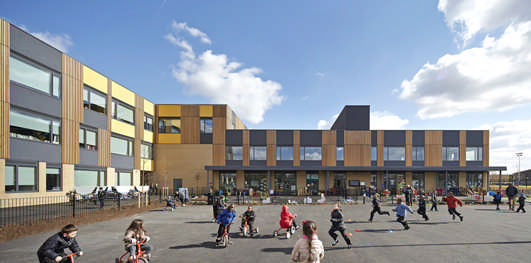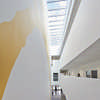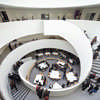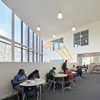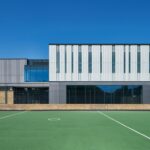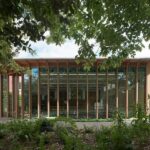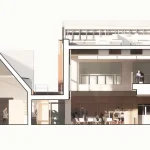Oasis Academy Enfield School Building, Innova Park, Mollison Avenue Design Photos
Oasis Academy Enfield
Specialist Maths, ICT and Music school, north London, England design by John McAslan + Partners
Location: Enfield, north London, UK
Design: John McAslan + Partners
Oasis Academy Enfield
Address: Innova Park, Kinetic Crescent, Enfield, Greater London EN3 7XH
Phone: 01992 655400
Oasis Academy
OASIS ACADEMY ENFIELD GOES GREEN
9 Aug 2013
Oasis Academy in Enfield
John McAslan + Partners’ newly completed Oasis Academy Hadley, Enfield – a specialist Maths, ICT and Music school – has been designed as a highly sustainable building.
Located on a former industrial site, the project sits at the heart of a wider urban regeneration plan for Ponders End and South Street. This ambitious scheme delivers a vibrant new learning campus for the Academy’s primary, secondary and sixth-form students and will also play a pivotal role as a new community hub, with a range of cultural and sports activities (indoor sports hall, dance studios, changing rooms, and an all-weather pitch and multi-use games area) available outside school hours. The school’s front facade addresses a new plaza, the intention being that this will be an animated civic space hosting markets, fêtes and community activities throughout the year.
Hannah Lawson, Project Director, comments: “Our design provides a clear, rational and legible arrangement of accommodation across the site. Four blocks of accommodation are arranged in a ‘pin-wheel’ configuration around a central Agora which forms the ‘heart’ of the academy. This arrangement allows the building to respond to the local context and key urban issues whilst addressing the principal objectives of the education brief.” The south block houses nursery and primary classrooms and the east and west blocks contain secondary classrooms. The learning communities are designed in a doughnut configuration, the classrooms arranged around a central circulation and open plan learning environment.
The Agora can be used for dining, assemblies, performance spaces and informal teaching; communal facilities such as the Library, ICT space, House Bases, Dining area, Kitchen and Drama studio are all accessed from this central space, creating a vibrant hub for academy activities. The configuration of the blocks and the central Agora, in particular the sightlines to the faculty entrances and to the external landscape, allow users to orientate themselves across the site.
The academy’s Principal, Lynne Dawes, adds: “The flexible design of this new Academy is driven by the school’s specialist teaching model which is organised around learning zones. At the heart of the building is a central Agora, a fantastic, dramatic space at the heart of the academy which provides an informal teaching area for learning. This is complemented by a series of 9 metre wide, open plan learning clusters, which allow for increased flexibility. John McAslan + Partners has delivered a scheme which responds brilliantly to the original brief.”
14 Jun 2013
Oasis Academy Building
The scheme incorporates a number of sustainable features which will significantly reduce the school’s carbon footprint, as well as generate renewable energy, the intention being to achieve a minimum of 20% generation of renewable energy on the site. These features include roof-mounted solar thermal and photovoltaic panels, heating plant configured to allow future connection to a Combined Heat and Power Plant (CHP), orientation to reduce solar gain, heat pumps and batteries and solar control glass. The solar thermal panels pre-heat the domestic hot water (HWS). In summer the system will serve the majority of the school’s requirements. The proposed community use of the facilities makes this technology more beneficial than closing the school during the summer months when the sun is of most use. This combination will provide a low maintenance, low operating cost solution for the Academy.
The photovoltaic panels will feed electricity into the building’s main board. The building is designed to be a net exporter of electricity during holiday periods and at weekends, meaning the building achieves a negative carbon footprint through exporting electricity, reduces running costs by using free electricity and can sell surplus electricity. The school will receive a tariff for all electricity generated, whether used by the school or exported. In addition, the configuration of the heating plant will allow for future connection to a possible CHP network.
The building has been designed to avoid, where possible, expansive east and west facing facades where low angles of solar gain cannot be managed. East and west-facing facades are limited to the two-storey primary school. The ground floor is shaded by an external canopy that provides covered external learning space.
The orientation of the building has specifically sought to ensure all major external play areas are south facing, including a rooftop terrace which will integrate a shading structure. These moves ensure a series of highly usable and climatically controlled spaces for the staff and students. The majority of the general teaching areas will be heated by a heater battery in the in-room ventilation unit, so leaving the external wall free of obstructions and maximizing flexibility in the placement of furniture. It is proposed that a large part of the heat for these units will be reclaimed from the air leaving the central breakout space areas. The Agora benefits from under floor heating, leaving walls unobstructed and providing uniform heating to this large space. Those areas provided with cooling, such as the Server room, Art/media design, Media and LRC, will be heated by their heat pump units.
Use of a light tint solar control glass is proposed to improve on the daylight/solar gain balance. Where possible, allowing for site constraints, the extent of east and west-facing glazing has been minimized. The learning resource centre has a north-facing façade to minimize computer screen glare and the art studios benefit from north-facing glazing to avoid shadowing for pupils. Key spaces are lit for most of the year, and the areas of glazing, especially to the general teaching spaces, have been optimized to strike a balance between providing generous levels of daylight and controlling overheating in summer. Windows to teaching areas on the perimeter have been sized on the basis of approximately 40% of the internal floor to ceiling area, while roof lights located above the Agora and the central break out/circulation spaces introduce natural daylight.
The proposals are obtaining accreditation through the Building Research Establishment’s assessment methods and achieved ‘Very Good’ rating at the BREEAM for Education 2008 Pre-Assessment stage.
Oasis Academy Hadley – Building Information
Client: Enfield Council
Lead Consultant: Balfour Beatty Education
Quantity Surveyor: Turner and Townsend
Engineers: Aecom
Project Manager: Navigant Consulting
Mossbourne Victoria Park Academy images / information from John McAslan + Partners
Mossbourne Victoria Park Academy London design : John McAslan + Partners
Address: 9 Kinetic Crescent, Innova Park, Mollison Avenue, Enfield, Greater London EN3 7XH
Contact: 01992 655400
Location: 9 Kinetic Crescent, Innova Park, Mollison Avenue, Enfield, London EN3 7XH
London, England, UK
London Buildings
Contemporary London Architecture Designs
London Architecture Designs – chronological list
London Architecture Tours by e-architect
London School Buildings
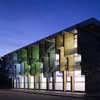
photo © Peter Cook
Education Buildings in North London
Bridge Academy, Hackney
Design: BDP Architects
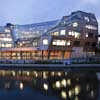
image © Martine Hamilton Knight
Bridge Academy London
Henrietta Barnett School, London NW11
Hopkins Architects
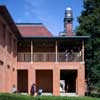
image : Richard Brine
Henrietta Barnett School
Tottenham Hotspur Training Facility Enfield
Lee Valley White Water Centre Enfield
Comments / photos for the Oasis Academy Enfield London Architecture page welcome

